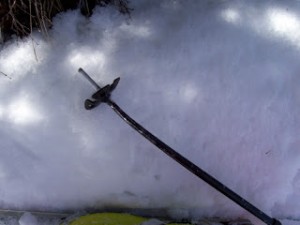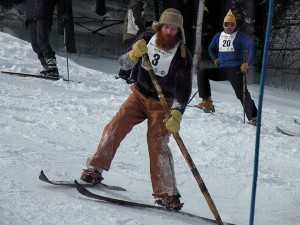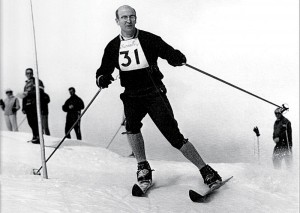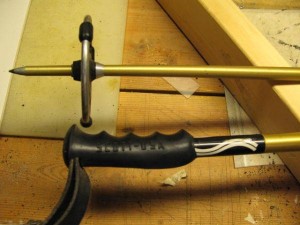Over President’s weekend I observed quite a few members of the Crooked Stick tribe on the slopes. The Crooked Stick tribe is that subset of skiers whose ski poles are anything but straight. I’m not talking about the poles used by downhill racers that are intentionally curved. I’m talking about those poles that are personalized with very random bends and twists. Behind each bend and twist is a story. Just walk up to any Crooked Stick member and ask them:
“That bend was when I fell on Needle’s Eye at Killington!”
“The one down near the basket was the mid-station at Mad River Glen.”
“Oh, those dents were when I backed over my poles in the parking lot!”

Red Lussier
In the history of skiing the Crooked Stick tribe is a relatively modern society. Early downhill skiers used just one wooden stick – and a big stick it was! That stick was used to turn by dragging it in the snow on one side or the other. Skiing survived with one pole for thousands of years. It wasn’t until the late 1800’s and the advent of the Telemark technique that skiing with two poles appeared, but they were still made of wood. Even when lift-served skiing began, poles were wooden with big floppy baskets. There was no Crooked Stick tribe since any mishap that involved a pole was likely to break the pole!
The Crooked Stick tribe probably first appeared during the 1940’s with the steel ski pole. Steel poles were more durable than the old wooden ones, but they were also heavier and more expensive. Aluminum poles also made their debut and while they were lighter than the steel poles, they were still heavier than the old wooden ones.
 In 1958 a ski shop owner in Sun Valley changed the world of ski poles. Ed Scott saw the shortcomings of the existing poles and designed a better ski pole. He used a tapered aluminum tube made of higher quality aluminum so that the walls could be thinner. He also used a small, light basket which would have previously been only considered for kids. The result was a light, strong pole and since it was tapered, the swing-weight of the pole was significantly better than anything on the market.
In 1958 a ski shop owner in Sun Valley changed the world of ski poles. Ed Scott saw the shortcomings of the existing poles and designed a better ski pole. He used a tapered aluminum tube made of higher quality aluminum so that the walls could be thinner. He also used a small, light basket which would have previously been only considered for kids. The result was a light, strong pole and since it was tapered, the swing-weight of the pole was significantly better than anything on the market.
Jack Pickett was the first correct responder to identify Scott as the inventor of the tapered aluminum ski pole. Jack says he still has a pair with the distinctive gold shaft, black grip, and silver basket. That’s certainly a testimony to their durability.
Ed Scott was an MIT educated easterner who got the skiing bug by working in a New York City ski shop in 1935. He dreamed of running his own ski shop, but it wouldn’t be until after World War II when he moved to Sun Valley that his dream would be realized.
 Scott’s attention to detail produced the best ski pole available and it would catch on quickly. His timing was excellent since the wedeln technique had become the way to ski and it relied on quick pole plants. By 1962 a majority of winning racers used Scott poles and the general public followed suit.
Scott’s attention to detail produced the best ski pole available and it would catch on quickly. His timing was excellent since the wedeln technique had become the way to ski and it relied on quick pole plants. By 1962 a majority of winning racers used Scott poles and the general public followed suit.
The poles were not cheap. In 1963 they cost $25 a pair when a pair of Head skis cost about $100. So if we translate that into today when a top pair of skis costs $800 or more, the poles would be $200. Scott defended the price and refused to compromise quality for the sake of price
Soon the aluminum ski pole would completely take over the market and the Crooked Stick tribe thrived! I believe I still have an old pair of poles in the garage where one of the poles has this strange bend just above the basket. That was when I forgot to lift my poles for the old mid-station on the Madonna lift!

April 5, 2013 at 3:34 pm
called Reporter since not tech savy who said had to go on computer to communicate with you re wk 17 Squaw article on being a contender for skiing Stowe the longest & still skiing! I have been on the Mt since born in 1948 & had tickets till passes started & had a pass ever since till @ 5 yr ago when moved to Smuggs but still ski Stowe with vouchers till got a new knee last yr but will be back next yr so that’s almost 60 yr on my beloved Mt!
January 8, 2022 at 1:33 am
I was Ed Scott’s UPS delivery driver when he was manufacturing Scott/Mathauser brake pads. The brake compound would come in odd poundage packages, with a COD cost calculated by weight, 40 lbs, 42 lbs, 48 lbs, etc., so the COD amount of each package was different, $351.62, $365.41, $385.64, etc.. Ed would sit at his desk with his eyes closed and I would read off the amount on each of 10 to 20 packages. When I was done reading, Ed would write a check for the total. I double checked him with a calculator the first time, when he said, “What? You don’t think I can do simple math?”, after that, I just turned in the check with the stubs at the end of the day. There was never a hitch in his method! He told me several times, “If you think you have a good idea for a patent, run it by me. I’ll help you file for a patent.” Thanks Ed! You were a real inspiration, a very special human being! RIP